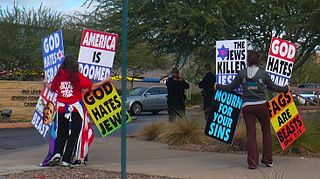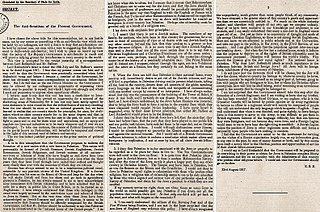Antisemitism is hostility to, prejudice towards, or discrimination against Jews. This sentiment is a form of racism, and a person who harbours it is called an antisemite. Though antisemitism is overwhelmingly perpetrated by non-Jews, it may occasionally be perpetrated by Jews in a phenomenon known as auto-antisemitism. Primarily, antisemitic tendencies may be motivated by negative sentiment towards Jews as a people or by negative sentiment towards Jews with regard to Judaism. In the former case, usually presented as racial antisemitism, a person's hostility is driven by the belief that Jews constitute a distinct race with inherent traits or characteristics that are repulsive or inferior to the preferred traits or characteristics within that person's society. In the latter case, known as religious antisemitism, a person's hostility is driven by their religion's perception of Jews and Judaism, typically encompassing doctrines of supersession that expect or demand Jews to turn away from Judaism and submit to the religion presenting itself as Judaism's successor faith—this is a common theme within the other Abrahamic religions. The development of racial and religious antisemitism has historically been encouraged by anti-Judaism, though the concept itself is distinct from antisemitism.
Philosemitism is a notable interest in, respect for, and appreciation of the Jewish people, their history, and the influence of Judaism, particularly on the part of a non-Jew. In the aftermath of World War II, the phenomenon of philosemitism saw a great increase throughout Europe following the Holocaust, reshaping the relationship between Jews and European societies. American historian G. Daniel Cohen states that philosemitism "can indeed easily recycle antisemitic themes, recreate Jewish otherness, or strategically compensate for Holocaust guilt".
New antisemitism is the concept that a new form of antisemitism which developed in the late 20th and early 21st centuries, tends to manifest itself as anti-Zionism and criticism of the Israeli government. The concept is included in some definitions of antisemitism, such as the working definition of antisemitism and the 3D test of antisemitism. The concept dates to the early 1970s, although the identification of anti-Zionism with antisemitism has "long been de rigueur in Jewish communal and broader pro-Israel circles".
The Stephen Roth Institute for the Study of Contemporary Antisemitism and Racism is a research institute at Tel Aviv University in Israel.

Different opinions exist among historians regarding the extent of antisemitism in American history and how American antisemitism contrasted with its European counterpart. Earlier students of American Jewish life minimized the presence of antisemitism in the United States, which they considered a late and alien phenomenon that arose on the American scene in the late 19th century. More recently however, scholars have asserted that no period in American Jewish history was free from antisemitism. The debate about the significance of antisemitism during different periods of American history has continued to the present day.
Antisemitism —prejudice, hatred of, or discrimination against Jews— has experienced a long history of expression since the days of ancient civilizations, with most of it having originated in the Christian and pre-Christian civilizations of Europe.

Antisemitism has existed for centuries in the United States. Most Jewish community relations agencies in the United States draw distinctions between antisemitism, which is measured in terms of attitudes and behaviors, and the security and status of American Jews, which are both measured by the occurrence of specific incidents. FBI data shows that in every year since 1991, Jews were the most frequent victims of religiously motivated hate crimes, according to a report which was published by the Anti-Defamation League in 2019. Evidence suggests that the true number of hate crimes against Jews is underreported, as is the case for many other targeted groups. In an attempt to combat anti-Semitism, the Biden administration launched the United States’ first-ever comprehensive U.S. National Strategy to Counter Antisemitism on May 25, 2023.

Anti-Zionism is opposition to Zionism. Although anti-Zionism is a heterogeneous phenomenon, all its proponents agree that the creation of the modern State of Israel, and the movement to create a sovereign Jewish state in the region of Palestine—the biblical Land of Israel—was flawed or unjust in some way.

Racism and xenophobia have been reported and investigated in Sweden. Sweden has the most segregated labor market of people with foreign background in Europe, when measured against both high and low educational level by OECD statistics. According to the European Network Against Racism, skin color and ethnic/religious background have significant impact on an individual's opportunities in the labor market.
The "three Ds" or the "3D test" of antisemitism is a set of criteria formulated by Israeli human rights advocate and politician Natan Sharansky in order to distinguish legitimate criticism of Israel from antisemitism. The three Ds stand for delegitimization, demonization, and double standards, each of which, according to the test, indicates antisemitism.
Jonathan Judaken was the Spence L. Wilson Chair in Humanities at Rhodes College. Judaken previously taught at the University of Memphis where he was the Dunavant Professor of History and Director of the Marcus Orr Center for the Humanities. His fields of expertise include European cultural and intellectual history, discussions of Jews and Judaism, race and racism, and post-Holocaust French philosophy. Judaken is a notable scholar of Jean-Paul Sartre and Sartre's relationship to Jews and Judaism and race and racism, as well as contemporary French Jewish philosophers.
Since World War II, antisemitic prejudice in Italy has seldom taken on aggressive forms.
Antisemitism in contemporary Hungary principally takes the form of negative stereotypes relating to Jews, although historically it manifested itself more violently. Studies show antisemitism has become more prevalent since the fall of Communism, particularly among the younger generations. Surveys performed from 2009 and beyond have consistently found high levels of antisemitic feelings amongst the general population.
Evidence for the presence of Jewish communities in the geographical area today covered by Austria can be traced back to the 12th century. In 1848 Jews were granted civil rights and the right to establish an autonomous religious community, but full citizenship rights were given only in 1867. In an atmosphere of economic, religious and social freedom, the Jewish population grew from 6,000 in 1860 to almost 185,000 in 1938. In March 1938, Austria was annexed by Nazi Germany and thousands of Austrians and Austrian Jews who opposed Nazi rule were sent to concentration camps. Of the 65,000 Viennese Jews deported to concentration camps, only about 2,000 survived, while around 800 survived World War II in hiding.
The working definition of antisemitism, also called the International Holocaust Remembrance Alliance definition of antisemitism or IHRA definition, is a non-legally binding statement on what antisemitism is, that reads: "Antisemitism is a certain perception of Jews, which may be expressed as hatred toward Jews. Rhetorical and physical manifestations of antisemitism are directed toward Jewish or non-Jewish individuals and/or their property, toward Jewish community institutions and religious facilities." Accompanying the working definition, but of disputed status, are 11 illustrative examples whose purpose is described as guiding the IHRA in its work, seven of which relate to criticism of the Israeli government. As such, pro-Israeli organizations have been advocates for the worldwide legal adoption of the definition.

Comparisons between Israel and Nazi Germany are a rhetorical staple of anti-Zionism in relation to the Israeli–Palestinian conflict. The legitimacy of these comparisons and their potential antisemitic nature is a matter of debate. Historically, figures like Arnold J. Toynbee have drawn parallels between Zionism and Nazism, a stance he maintained despite criticism. Scholar David Feldman and the Anti-Defamation League (ADL) have provided contrasting views; Feldman suggests these comparisons are often rhetorical tools without specific antisemitic intent, while the ADL sees them as diminishing the Holocaust's significance.
The international Jewish conspiracy or world Jewish conspiracy has been described as "the most widespread and durable conspiracy theory of the twentieth century" and "one of the most widespread and long-running conspiracy theories". Although it typically claims that a malevolent, usually global Jewish circle, referred to as International Jewry, conspires for world domination, the conspiracy theory's content is extremely variable, which helps explain its wide distribution and long duration. It was popularized in the late nineteenth and early twentieth century especially by the antisemitic forgery The Protocols of the Elders of Zion. Among the beliefs that posit an international Jewish conspiracy are Jewish Bolshevism, Cultural Marxism, Judeo-Masonic conspiracy theory, White genocide conspiracy theory and Holocaust denial. The Nazi leadership's belief in an international Jewish conspiracy that it blamed for starting World War II and controlling the Allied powers was key to their decision to launch the Final Solution.
"Hitler was right" and "Hitler did nothing wrong" are controversial statements and internet memes either expressing support for Nazi dictator Adolf Hitler or trolling. The ironic or trolling uses of the phrase allow actual neo-Nazis to maintain plausible deniability over their neo-Nazi views.
Zionist antisemitism is the phenomenon in which individuals, groups, or governments support the Zionist movement and the State of Israel while simultaneously holding antisemitic views about Jews. In some cases, Zionism may be promoted for explicitly antisemitic reasons. The prevalence of antisemitism has been widely noted within the Christian Zionist movement, whose adherents may hold antisemitic beliefs about Jews while also supporting Zionism for eschatological reasons. Antisemitic right-wing nationalists, particularly in Europe and the United States, sometimes support the Zionist movement because they wish for Jews to be expelled, or for Jews to emigrate to Israel, or because they view Israel as a supremacist ethno-state to be admired and held up as a model for their own countries.
Antisemitism in the People's Republic of China is a mostly 21st century phenomenon and is complicated by the fact that there is little ground for antisemitism in China in historical sources. In the 2020s, antisemitic conspiracy theories in China began to spread and intensify. Some Chinese people believe in antisemitic tropes that Jews secretly rule the world and are business-minded.





